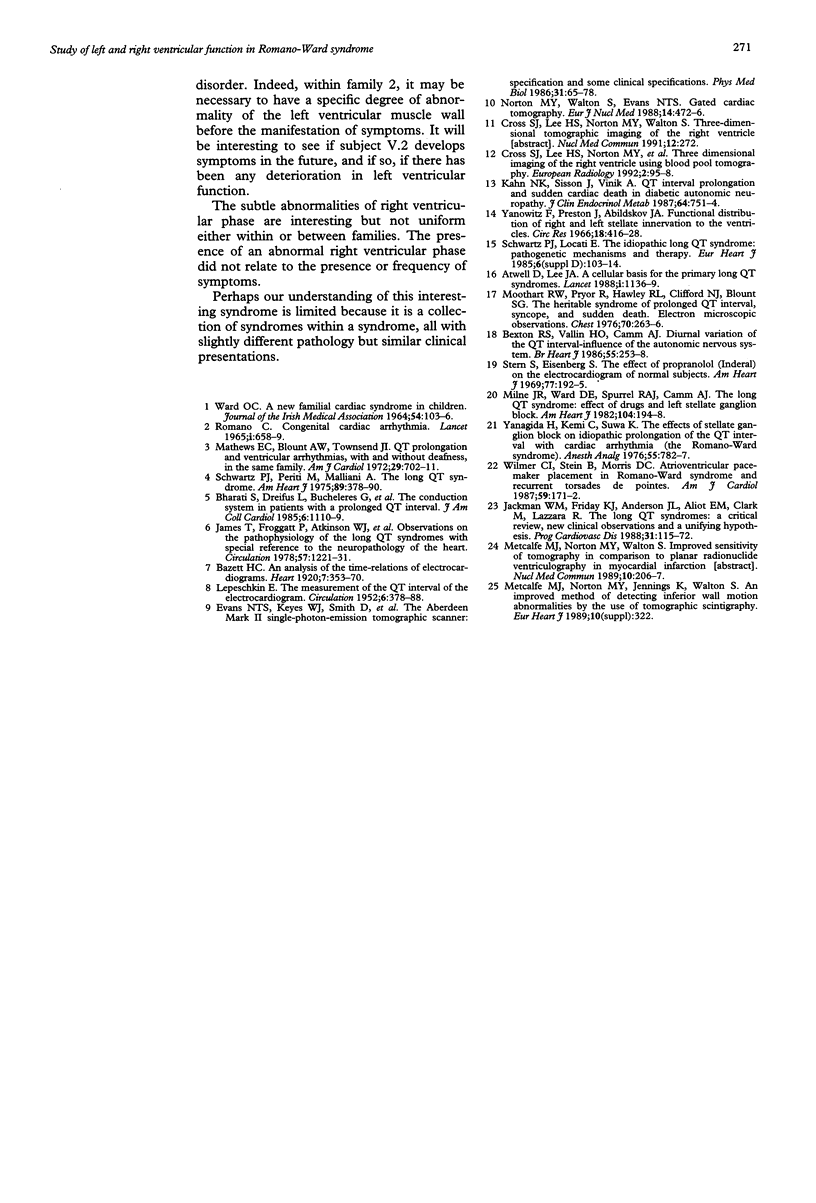Abstract
OBJECTIVE--To examine left and right ventricular contraction in Romano-Ward syndrome: does abnormal myocardium affect the predisposition to arrhythmia? DESIGN--Tomographic radionuclide ventriculography was performed after the red blood cells were labelled conventionally with stannous pyrophosphate and technetium-99m. SETTING--Department of Nuclear Medicine, Aberdeen Royal Infirmary. PATIENTS--Eight subjects from two families known to have Romano-Ward syndrome, four of whom (two from each family) had had symptoms. RESULTS--The five subjects from family 1 had normal left ventricular contraction; two had subtle abnormalities of right ventricular phase. in family 2 all three subjects had abnormal left ventricular contraction (reduced amplitude in three, abnormal phase in two). All had subtle abnormalities of right ventricular phase. CONCLUSION--Abnormal right or left ventricular myocardium may be partly or wholly responsible for the repolarisation changes seen on the electrocardiogram of these families or may act as an ectopic focus to start ventricular tachycardias in a susceptible heart.
Full text
PDF





Images in this article
Selected References
These references are in PubMed. This may not be the complete list of references from this article.
- Bexton R. S., Vallin H. O., Camm A. J. Diurnal variation of the QT interval--influence of the autonomic nervous system. Br Heart J. 1986 Mar;55(3):253–258. doi: 10.1136/hrt.55.3.253. [DOI] [PMC free article] [PubMed] [Google Scholar]
- Bharati S., Dreifus L., Bucheleres G., Molthan M., Covitz W., Isenberg H. S., Lev M. The conduction system in patients with a prolonged QT interval. J Am Coll Cardiol. 1985 Nov;6(5):1110–1119. doi: 10.1016/s0735-1097(85)80317-x. [DOI] [PubMed] [Google Scholar]
- Corey L., Whitley R. J., Stone E. F., Mohan K. Difference between herpes simplex virus type 1 and type 2 neonatal encephalitis in neurological outcome. Lancet. 1988 Jan 2;1(8575-6):1–4. doi: 10.1016/s0140-6736(88)90997-x. [DOI] [PubMed] [Google Scholar]
- Evans N. T., Keyes W. I., Smith D., Coleman J., Cumpstey D., Undrill P. E., Ettinger K. V., Ross K., Norton M. Y., Bolton M. P. The Aberdeen Mark II single-photon-emission tomographic scanner: specification and some clinical applications. Phys Med Biol. 1986 Jan;31(1):65–78. doi: 10.1088/0031-9155/31/1/006. [DOI] [PubMed] [Google Scholar]
- Jackman W. M., Friday K. J., Anderson J. L., Aliot E. M., Clark M., Lazzara R. The long QT syndromes: a critical review, new clinical observations and a unifying hypothesis. Prog Cardiovasc Dis. 1988 Sep-Oct;31(2):115–172. doi: 10.1016/0033-0620(88)90014-x. [DOI] [PubMed] [Google Scholar]
- James T. N., Froggatt P., Atkinson W. J., Jr, Lurie P. R., McNamara D. G., Miller W. W., Schloss G. T., Carroll J. F., North R. L. De subitaneis mortibus. XXX. Observations on the pathophysiology of the long QT syndromes with special reference to the neuropathology of the heart. Circulation. 1978 Jun;57(6):1221–1231. doi: 10.1161/01.cir.57.6.1221. [DOI] [PubMed] [Google Scholar]
- Kahn J. K., Sisson J. C., Vinik A. I. QT interval prolongation and sudden cardiac death in diabetic autonomic neuropathy. J Clin Endocrinol Metab. 1987 Apr;64(4):751–754. doi: 10.1210/jcem-64-4-751. [DOI] [PubMed] [Google Scholar]
- LEPESCHKIN E., SURAWICZ B. The measurement of the Q-T interval of the electrocardiogram. Circulation. 1952 Sep;6(3):378–388. doi: 10.1161/01.cir.6.3.378. [DOI] [PubMed] [Google Scholar]
- Mathews E. C., Jr, Blount AW BLOUNT A. W., Jr, Townsend J. I. Q-T prolongation and ventricular arrhythmias, with and without deafness, in the same family. Am J Cardiol. 1972 May;29(5):702–711. doi: 10.1016/0002-9149(72)90174-9. [DOI] [PubMed] [Google Scholar]
- Milne J. R., Ward D. E., Spurrell R. A., Camm A. J. The long QT syndrome; effects of drugs and left stellate ganglion block. Am Heart J. 1982 Aug;104(2 Pt 1):194–198. doi: 10.1016/0002-8703(82)90191-0. [DOI] [PubMed] [Google Scholar]
- Moothart R. W., Pryor R., Hawley R. L., Clifford N. J., Blount S. G., Jr The heritable syndrome of prolonged Q-T interval, syncope, and sudden death. Electron microscopic observation. Chest. 1976 Aug;70(2):263–266. doi: 10.1378/chest.70.2.263. [DOI] [PubMed] [Google Scholar]
- Norton M. Y., Walton S., Evans N. T. Gated cardiac tomography. Eur J Nucl Med. 1988;14(9-10):472–476. doi: 10.1007/BF00252391. [DOI] [PubMed] [Google Scholar]
- ROMANO C. CONGENITAL CARDIAC ARRHYTHMIA. Lancet. 1965 Mar 20;1(7386):658–659. doi: 10.1016/s0140-6736(65)91761-7. [DOI] [PubMed] [Google Scholar]
- Schwartz P. J., Locati E. The idiopathic long QT syndrome: pathogenetic mechanisms and therapy. Eur Heart J. 1985 Nov;6 (Suppl 500):103–114. doi: 10.1093/eurheartj/6.suppl_d.103. [DOI] [PubMed] [Google Scholar]
- Schwartz P. J., Periti M., Malliani A. The long Q-T syndrome. Am Heart J. 1975 Mar;89(3):378–390. doi: 10.1016/0002-8703(75)90089-7. [DOI] [PubMed] [Google Scholar]
- Stern S., Eisenberg S. The effect of propranolol (Inderal) on the electrocardiogram of normal subjects. Am Heart J. 1969 Feb;77(2):192–195. doi: 10.1016/0002-8703(69)90350-0. [DOI] [PubMed] [Google Scholar]
- WARD O. C. A NEW FAMILIAL CARDIAC SYNDROME IN CHILDREN. J Ir Med Assoc. 1964 Apr;54:103–106. [PubMed] [Google Scholar]
- Wilmer C. I., Stein B., Morris D. C. Atrioventricular pacemaker placement in Romano-Ward syndrome and recurrent torsades de pointes. Am J Cardiol. 1987 Jan 1;59(1):171–172. doi: 10.1016/s0002-9149(87)80098-x. [DOI] [PubMed] [Google Scholar]
- Yanagida H., Kemi C., Suwa K. The effects of stellate ganglion block on the idiopathic prolongation of the Q-T interval with cardiac arrhythmia (the Romano-Ward syndrome). Anesth Analg. 1976 Nov-Dec;55(6):782–787. doi: 10.1213/00000539-197611000-00007. [DOI] [PubMed] [Google Scholar]
- Yanowitz F., Preston J. B., Abildskov J. A. Functional distribution of right and left stellate innervation to the ventricles. Production of neurogenic electrocardiographic changes by unilateral alteration of sympathetic tone. Circ Res. 1966 Apr;18(4):416–428. doi: 10.1161/01.res.18.4.416. [DOI] [PubMed] [Google Scholar]







